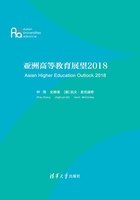
Chapter 1
Key Trends Shaping Asian Higher Education
1.1 Introduction and Overview
Asia is a unique region with vast land, huge population, long history, and cultural diversity. Asia has experienced significant changes over the past three decades, and with it the higher education landscape has evolved. The economy of Asia has continued to grow despite significant disruptions from two financial crises. The geopolitical scenario has changed substantially in recent years. Developing countries such as China and India and regional organizations such as the Association of Southeast Asian Nations (ASEAN) and Shanghai Cooperation Organization have emerged as major economic and political powers. Moreover, the combined forces of rapid urbanization, pervasive globalization, and transformative digital technologies have drawn people, markets, work, and learning into ever-closer networks.
This chapter sets out to unpack the socio-economic and higher education and research contexts of AUA universities' home countries and regions (Figure 1.1 and 1.2).

Figure 1.1 Economy and Demography of AUA Universities' Home Countries and regions in 2015

Figure 1.2 Academic Publications and Patent of AUA Universities in 2016
Furthermore, this chapter examines eight important trends that have shaped Asian higher education landscape over the past few decades. Instead of including all possible trends and influences here, a select set of trends are discussed based on the availability of internationally comparable, long-term evidence. This discussion should serve as stimulus for considering major tendencies that have the potential to influence the future of Asian higher education and the role of AUA within it, as well as the potential of Asian higher education to influence these broader trends.
The data source of figures in this chapter, unless stated otherwise, is the World Bank International Comparison Program database as of July 2017(1).